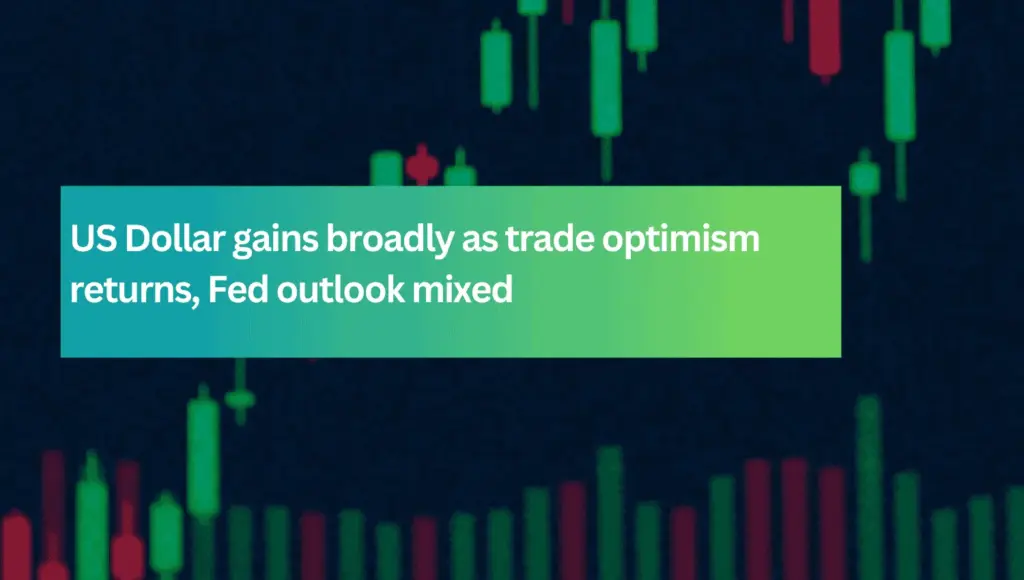News

The U.S. dollar’s seven-day advance abruptly reversed course on Wednesday after reports indicated President Donald Trump was seriously considering firing Federal Reserve Chair Jerome Powell. These headlines sparked sharp volatility, initially pressuring the greenback significantly. Although Trump later described the reports as "highly unlikely" and dismissed them as untrue, he acknowledged ongoing frustration with Powell over interest rates, leaving markets wary about the Fed's leadership and future monetary policy. Earlier, the dollar had drawn robust support from upbeat bank earnings and reassuring economic data, notably softer-than-expected June producer price figures and encouraging signs of manufacturing recovery. U.S. Trade Representative Jamieson Greer’s commitment to reducing America's $1.2 trillion trade deficit had also bolstered investor confidence. However, the Powell speculation undermined these bullish factors, causing the dollar index to retreat toward its critical 21-day moving average at 97.75, as investors cautiously awaited upcoming economic releases. EUR/USD volatile amid tariff and policy uncertainty EUR/USD traded within a wide 160-pip range before stabilizing modestly higher, but it remained below the crucial 21-day moving average at 1.1672. Markets closely monitored EU trade chief Maros Sefcovic’s trip to Washington aimed at preventing disruptive U.S. tariffs. Encouragingly, the euro’s one-month risk reversal rose above parity, signaling easing bearish sentiment and potentially supporting further stabilization. Nonetheless, uncertainty regarding U.S. monetary policy and transatlantic trade negotiations continued to weigh on sentiment. Sterling boosted by surprise UK inflation spike GBP/USD jumped temporarily towards its pivotal 55-day moving average at 1.3483 after UK inflation data for June surprised markets, accelerating sharply to 3.6%. This unexpected rise in CPI challenged prior expectations of imminent Bank of England easing, creating renewed debate on the BoE’s next policy move. However, BoE rate-setter Catherine Mann voiced caution, warning that sustained demand without matching supply-side improvements could produce a risky economic "sugar high," tempering market enthusiasm and highlighting underlying vulnerabilities in Britain's economic outlook. USD/JPY retreats amid falling yields and tariff threats USD/JPY fell sharply, following declines in U.S. Treasury yields triggered by Powell-related uncertainty. Traders significantly trimmed bullish yen positions, although key technical supports around the 200-hour moving average and the July 10 peak (146.78) held firm, indicating lingering buying interest. Further complicating yen sentiment, President Trump indicated intentions to enforce a 25% tariff on Japanese imports from August 1, heightening bilateral tensions and risk premiums around the yen’s outlook. Treasury yields fall; equities rise cautiously Treasury yields broadly retreated, falling by up to 7 basis points across the curve, although the 2-year to 10-year spread modestly steepened to around +53.2 basis points. Equity markets reacted positively despite volatility, with the S&P 500 climbing 0.31%, largely driven by gains in healthcare stocks. However, investor caution persisted amid ongoing trade uncertainties and Fed leadership questions. Mixed commodities reflect cautious investor sentiment Commodity markets exhibited mixed performance. WTI crude oil edged 0.33% higher, supported by underlying demand strength despite rising inventories. Gold benefited from lower Treasury yields and market caution, rising by 0.76%. Conversely, copper prices declined by 0.75%, reflecting persistent investor unease over global trade tensions and broader economic uncertainties.

The U.S. dollar strengthened notably on Monday, supported by improved market sentiment following President Donald Trump's indication of willingness to engage in trade negotiations with the European Union and other major trading partners ahead of the scheduled tariff increases on August 1. Trump's conciliatory stance provided relief to global markets, while his announcement of additional military aid for Ukraine and a warning of sanctions against countries buying Russian exports without a peace agreement introduced fresh geopolitical complexity. Furthermore, Trump’s anticipated unveiling of a substantial $70 billion investment package focusing on artificial intelligence and energy initiatives further buoyed market sentiment, underpinning dollar strength. Treasury yields rose modestly, with investors positioning ahead of crucial U.S. inflation data due on Tuesday and major bank earnings reports expected later this week. The yield curve steepened slightly, as the closely watched 2s-10s yield spread widened marginally to around +52.2 basis points, reflecting investor caution amid shifting expectations around the Federal Reserve’s policy trajectory. Mixed Fed commentary clouds rate outlook Federal Reserve officials provided diverging signals, complicating investor expectations. Cleveland Fed President Beth Hammack maintained an optimistic tone, asserting inflation remains elevated and implying there was no immediate rationale for rate cuts. In contrast, Fed Chair Jerome Powell faced scrutiny as he called for an internal review into cost overruns associated with Fed headquarters renovations, responding to mounting criticism from Trump administration officials. Amid these developments, White House economic adviser Kevin Hassett emerged as a leading contender to become the next Fed chief, fueling speculation regarding possible future shifts in central bank leadership and policy. Euro pressured amid EU-US trade tensions EUR/USD declined, slipping below the crucial 21-day moving average at 1.1660, pressured by intensifying trade tensions and uncertainties surrounding U.S. tariff policies. European Union officials openly criticized the U.S. for perceived delays in advancing trade negotiations, warning of potential countermeasures if a comprehensive agreement is not swiftly reached. Technical signals indicate the possibility of further euro losses, with key downside targets at the significant April high around 1.1573, followed by the psychologically important 1.15 level. Sterling declines sharply on dovish BoE comments GBP/USD fell notably, pressured by growing expectations of imminent rate cuts from the Bank of England. Governor Andrew Bailey’s notably dovish comments on persistent UK labor market weakness and subdued economic growth exacerbated sterling selling pressure. Technically, cable decisively breached its critical 55-day moving average, moving towards key support around the 2024 high at 1.3434, as risk reversals turned notably bearish. The next pivotal support lies at the June low near 1.3373. Meanwhile, EUR/GBP rose toward its year-to-date peak of 0.8740, reflecting narrowing EU-UK yield differentials ahead of crucial UK inflation data on Wednesday. USD/JPY hits three-week highs on rising yields, election positioning USD/JPY surged to fresh three-week highs, driven by rising U.S. Treasury yields, widespread dollar strength, and active option-related buying as investors positioned ahead of Japan's upcoming Upper House elections this weekend. The currency pair is now strategically poised to challenge important resistance levels, notably the June high at 148.02 and the significant technical zone around 148.65, if current bullish momentum continues. Commodity currencies weaker, AUD pressured ahead of China data AUD/USD retreated modestly, pressured by declining metals prices and cautious positioning before China’s closely-watched GDP data release on Tuesday. Traders remain wary amid uncertainties regarding Chinese economic recovery, which could directly impact Australia's resource-dependent economy. Equities cautiously optimistic; commodities mixed amid geopolitical concerns Global equity markets remained cautiously optimistic, with the S&P 500 advancing moderately by 0.20%, primarily driven by gains in consumer services and financial sector stocks. Conversely, commodity markets exhibited mixed trends: oil prices dropped significantly by 2%, weighed down by investor anxieties related to Trump’s renewed threats of sanctions targeting purchasers of Russian energy exports. Gold prices ended largely unchanged, relinquishing initial gains as dollar strength dominated sentiment. Copper prices declined modestly by 0.91%, reflecting both a stronger dollar and persistent trade-related uncertainties affecting global demand prospects.
